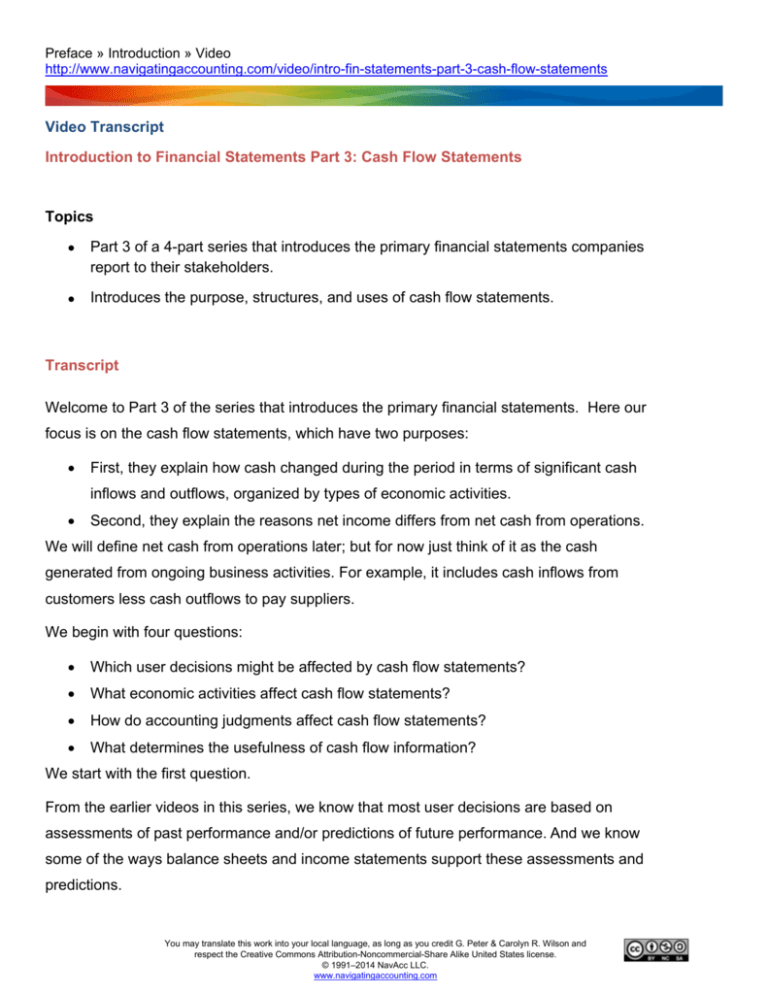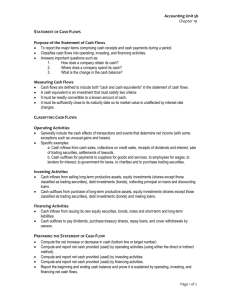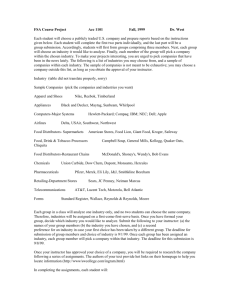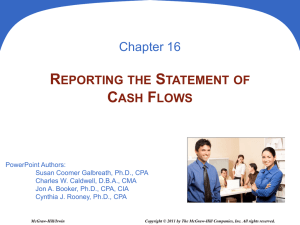Video Transcript Introduction to Financial Statements Part 3: Cash
advertisement

Preface » Introduction » Video http://www.navigatingaccounting.com/video/intro-fin-statements-part-3-cash-flow-statements Video Transcript Introduction to Financial Statements Part 3: Cash Flow Statements Topics Part 3 of a 4-part series that introduces the primary financial statements companies report to their stakeholders. Introduces the purpose, structures, and uses of cash flow statements. Transcript Welcome to Part 3 of the series that introduces the primary financial statements. Here our focus is on the cash flow statements, which have two purposes: First, they explain how cash changed during the period in terms of significant cash inflows and outflows, organized by types of economic activities. Second, they explain the reasons net income differs from net cash from operations. We will define net cash from operations later; but for now just think of it as the cash generated from ongoing business activities. For example, it includes cash inflows from customers less cash outflows to pay suppliers. We begin with four questions: Which user decisions might be affected by cash flow statements? What economic activities affect cash flow statements? How do accounting judgments affect cash flow statements? What determines the usefulness of cash flow information? We start with the first question. From the earlier videos in this series, we know that most user decisions are based on assessments of past performance and/or predictions of future performance. And we know some of the ways balance sheets and income statements support these assessments and predictions. You may translate this work into your local language, as long as you credit G. Peter & Carolyn R. Wilson and respect the Creative Commons Attribution-Noncommercial-Share Alike United States license. © 1991–2014 NavAcc LLC. www.navigatingaccounting.com 2 So, just how do cash flow statements provide additional information? Regarding past performance, insiders and outsiders use cash flow statements to assess how effectively cash was managed during the current period, given the company’s goals and strategies. Regarding future performance, cash flow statements help users predict the extent to which the company will meet its future cash needs and distribute cash to owners. Balance sheets, income statements, and cash flow statements all provide information that helps users predict future cash flows, in ways that complement each other. For example, on September 28, 2013 Apple reported nearly $150 billion in cash, and other assets that could readily be converted to cash, which was over 70% of its total assets at that time. Apple also reported $37 billion of net income during the year that ended at this balance sheet date. So, outsiders probably didn’t need to look at Apple’s cash flow statement to safely conclude Apple would have sufficient cash to meet its needs for the foreseeable future, including paying its obligations, funding new initiatives, or even surviving another economic downturn. In fact, many outsiders have argued that Apple should have returned some of its cash to investors as dividends. These outsiders could have bolstered their arguments using Apple’s cash flow statement. It reported that Apple generated $54 billion of net cash from operations during this same year, which was nearly 50% higher than its net income. The cash flow statement also showed that this pattern has persisted for three years, suggesting, net cash from operations was a better predictor of Apple’s future cash flows than its net income, at least in the short run. Here are two key related observations: First, outsiders can often learn a great deal about a company’s future cash flows, beyond what they learn from balance sheets and income statements, by studying cash flow statements, especially the section that explains why net income differs from net cash from operations. Second, while Apple’s net income was much less than its net cash from operations, the opposite can also be true. Thus, net income can be larger or smaller than net cash from operations, and significantly so. 3 So, why do net income and net cash from operations often differ? Because income measures, such as revenues and expenses, can be recognized in income statements in different periods than the related cash flows. For example, depending on the business context, cash can be collected from customers before, at the same time, or after the criteria for revenue recognition are met and revenue is reported on the income statements. For example, if you purchase a car and promise to pay for it over time, the car company will recognize the revenue at the time of the sale, even though they didn’t receive all the cash for the sale at that time. This means revenue related to this sale, and thus net income, will be much greater than net cash from operations during the current year, and the opposite will be true in ensuing years when you make the car payments. Importantly, it also means insiders and outsiders need to assess the likelihood the company will collect the scheduled payments from customers like you. We say this is an assessment of the “quality of the revenues”, meaning the likelihood they will be collected in the future. There are two reasons the revenues might not be collected: The first centers on the risks related to the underlying economic activity: customers may not make the scheduled payments. The second centers on the accounting judgments associated with revenue recognition, which can be very complex in some contexts. These judgments open the door for honest errors or fraud. In assessing the quality of revenues, that is the likelihood they will be collected, outsiders must assess the risks associated with the underlying economic activity and the related accounting judgments. The quality of revenues concept generalizes to the other components of income, such as expenses, gains and losses and we say outsiders assess the “quality of earnings”, meaning their usefulness for predicting future earnings and cash flows. Similar to assessing the quality of revenues, when assessing the quality of earnings, outsiders must consider risks associated with the underlying economic activity and the credibility of the related accounting judgments. Importantly, virtually all of these risks and judgments are reflected in the adjustments in the operating section of the cash flow statement that we will be discussing later. 4 Next, we address the second question posed at the start of the video: What economic activities affect cash flow statements? To facilitate users’ decisions, cash flow statements classify cash flows as either: financing, investing, or operating. The cash flow statement reports the net cash flows from financing activities, investing activities, and operating activities, as well as line items specific to these activities. By net cash flow, we mean, the sum of the related cash inflows less the sum of the related cash outflows. Financing cash flows pertain to cash flows companies get from external parties to “finance” the business, and the cash they later repay to these parties. With one exception, they include all cash flows distributed to, or received from, owners and debt holders. The exception is debt interest payments, which must be classified as operating cash flows under US accounting standards, and can be classified as either operating or financing under international standards. For instance, if you take out a college loan, the cash you receive is a financing cash flow. It finances your education. Investing cash flows pertain to cash used to purchase long-term assets, meaning assets that are expected to provide benefits for more than a year, and to cash received if these assets are later sold. They also include cash used to purchase investment securities, such as another company’s shares, and the cash received if these investment securities are sold. For example, if you purchase a computer for cash, the cash outflow would be classified as an investing activity. Operating cash flows are all cash flows not classified as financing or investing. So, it’s a residual concept. As indicated earlier, operating cash flows usually pertain to ongoing business activities that occur repeatedly during each reporting period. For example, if you use cash to purchase a meal, this cash outflow would be classified as an operating activity. Based on the discussion thus far, you might be thinking that only economic activities that involve cash, such as disbursing or receiving cash, affect cash flow statements. This is true for financing and investing activities: they only include events that affect cash. However, this is not the case for operating activities. So, let’s see how the purpose of cash flow statements results in non-cash activities affecting the operating section of cash flow statements. 5 We begin with the first purpose of cash flow statements, which is to explain how cash changed during the period in terms of significant cash inflows and outflows, organized by types of economic activities. Now, we now know these activities are operating, investing and financing activities. If this was the only purpose, the operating section, as well as the financing and investing sections, would all report only cash inflows and outflows. For the operating section, this would mean, only operating activities affecting cash and thus net cash from operations would be included. However, there is a second, important purpose of the statement. The second purpose is to explain the reasons net income differs from net cash from operations. Importantly, net cash from operations is still the sum of the operating cash inflows less the sum of the operating outflows. But the second purpose is not to explain these cash flows. Rather, it is to explain how their net effect on cash differs from net income. To meet this purpose, the operating section of the cash flow statement starts with net income, followed by several adjustments that collectively explain why income differs from net cash from operations. This is called the “reconciliation of net income to net cash from operations”, because it reconciles, or explains, why net income differs from net cash from operations. An implication of the reconciliation is that activities that affect net income or net cash from operations will affect the operating section of the cash flow statement. Either one. The two circles illustrate the economic activities that affect the reconciliation, and thus, the operating section. Income measures can be recognized in the same period as related cash flows or in earlier or later. The red circle on the right includes all of the activities that affect net income. The blue circle on the left, well, it includes all of the activities that affect net cash from operations. The overlap includes activities that affect both net income and net cash from operations. For example, if Starbucks sells you coffee for cash, revenues, and thus net income, increase and net cash from operations increases. All at the same time. So, there’s no need for an adjustment. Income increases. Cash increases. The region on the left that is inside the blue circle, but outside the red circle, includes activities that affect net cash from operations, but don’t affect income. For example, if you purchase a Starbucks gift card for a friend with cash, Starbucks records a cash inflow, which 6 increases cash from operations, but revenue, and thus income, is not recognized until your friend uses the gift card. Thus, these types of activities partly explain why net income differs from net cash from operations. But this is precisely what the adjustments do, so for activities in this region adjustments are needed to explain why net income differs from net cash from operations. We need adjustments. We’ll study these adjustments in great detail in the cash flow statement modules. The region on the right side that is inside the red circle, but outside the blue circle includes activities that affect net income but do not affect net cash from operations. For example, if you purchase a garment using a store credit card and take home the garment, the retailer recognizes revenue (income) but not cash until you pay the store credit card bill later. Thus, these types of activities also partly explain why net income differs from net cash from operations. Accordingly, activities in this region affect both the adjustments and net income. So, they affect income and affect adjustments. But they don’t affect cash from operations. Next, we discuss the third decision posed at the start of the video: How do accounting judgments affect cash flow statements? Standard setters and/or companies make three judgments that effect cash flow statements: First, standard setters determine how activities are classified. We’ve already seen one situation where US and international standard setters have made different classification judgments: Interest payments must be classified as operating cash flows under US standards; but may be classified as either operating or financing under international standards. Second standard setters and companies determine the level of detail that’s reported on the cash flow statement. This will become apparent as we study cash flow statements later in the course. Third, standard setters and companies determine whether the operating sections are reported using either a direct or indirect format. Next, we preview these two formats. Direct cash flow statements, meaning those that use the direct format for the operating section, meet the first purpose of cash flow statement by including significant cash inflows and outflows in the operating section. For example, they include customer collections and 7 supplier payments. Direct refers to the fact that net cash from operations is derived directly from operating cash inflows and cash outflows. By contrast, indirect cash flow statements, meaning those that use the indirect format for the operating section, meet the second purpose of cash flow statements. By reconciling net income to net cash from operations, as discussed earlier. Indirect means net cash from operations is derived indirectly from income rather than directly from operating cash flows. Only the operating sections differ for the two formats. The investing and financing sections are identical. Both US and international standard setters allow companies to choose which format they wish to report for the operating section. Nevertheless, both encourage the direct format. Most companies report the indirect format; but US and international standard setters are considering mandating the direct approach on the statement, with supplementary disclosure of the reconciliation in footnotes. Next, we close the video by briefly addressing the fourth question posed earlier: What determines the usefulness of cash flow statement information? Cash flow information is useful to the extent it helps users make more informed decisions, which we know from the earlier discussion means helps users do two things: First, assess how effectively cash was managed. More specifically, assess how efficiently and effectively cash was managed, given the company’s operating, investing and financing goals and strategies. Second, predict the company’s capacity to meet future cash needs and distribute cash to owners. Among other things, this includes using the reconciliation adjustments in the operating section to assess the quality of earnings. We will discuss these issues in great detail later in the course when we analyze cash flow statements. Hope you enjoyed this video. See you in the next one.




